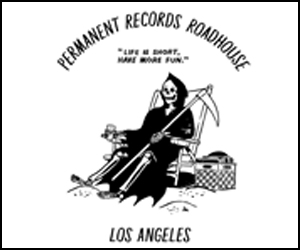Ride celebrate the past while living in the now at the sold-out Teragram
Staff Editor on
1

By SCOTT TIMBERG
Drones, overdrive, distortion, overtones — Ride shared all the same guitar-noise ingredients with their peers in the English shoegaze scene. Unlike the rest of these pale, bashful bands that briefly illuminated British pop about three decades ago, though, Ride had something else: a love of melody, a knack for vocal harmonies and a fondness for traditional songcraft that was almost Beatlesque. Underneath the swirling chaos, there was often something yearning, boyish.
A day after their surprise gig at the Desert Daze festival, Ride delivered all of these ingredients Monday night at the sold-out Teragram Ballroom, and offered an element less expected from a group whose biggest heat arrived in the early ’90s: a set list driven largely by the band’s new (and newish) songs. Though the Oxford quartet eventually played many of its early classics – “Vapour Trail,” “Taste,” “Leave Them All Behind,” “Drive Blind,” “OX4,” a tough, cacophonous encore of “Seagull” – the show framed the group as a living, outward-looking band rather than a nostalgia act.
It’s hard to argue that the songs from the group’s two post-reunion albums – 2017’s “Weather Diaries” and the August-released “This Is Not a Safe Place” – are superior to the best work of the band’s heyday, but the devoted, sellout crowd hardly minded. (The show’s opening two songs, “Jump Jet” and “Future Love,” both came from the new LP.) Post-millennial or pre, Ride put everything across with an intensity and focus that made it hard to imagine the group had spent two decades broken up.
Otherwise, the band’s approach is about the same as it used to be: Mark Gardener’s wistful vocals, Andy Bell’s beautifully assaultive guitar parts, solid-as-stone rhythm section of bassist Steve Queralt and drummer Loz Colbert. It’s all played very loud and in a locked-in way that can be a wonder to behold. The Teragram’s superior sound brought out both the guitar textures and the overwhelming wall of sound the band trades in.
Totally missing Monday night were songs from the last two LPs in the band’s original run, “Carnival of Light” and “Tarantula.” Not well-liked on their original release and associated with the group’s fragmenting and breakup, these albums still offer a handful of well-realized songs the group should consider reviving despite the pain around their making. “Only Now,” “Crown of Creation,” “I Don’t Know Where It Comes From,” “Walk on Water” and “Starlight Motel” don’t share the sound of the “Going Blank Again” LP and earlier Ride –- they’re inspired more by Big Star and the Byrds than “Psychocandy” — but they’re too good to be completely abandoned by the band that recorded them.
Like every pop movement before and since, the original shoegazers drew from existing sounds – Sonic Youth, Jesus and Mary Chain, Cocteau Twins. But the best of what they came up with was bracing and original. How can guitars do that? It’s hard to recall just how fresh it sounded in 1990 to hear Ride’s “Nowhere” LP, or My Bloody Valentine’s “Loveless” a year later, or the best songs of Slowdive a bit after. At a time when indie rock was arguably the most adventurous brand of pop music, this was (as we used to say) its cutting edge.
Seeing Ride in 2019 means something else. But what is that? Despite the genre’s reputation for reticence — “shoegaze” was originally the British press’s term for bands that stared at their feet, or perhaps guitar pedals, while playing — the band doesn’t seem to be getting lost in the ambiguities. Their Teragram show was confident, muscular, driven by new energy, and suggested that they might someday be back for more.
||| Live: Ride plays tonight at the Observatory. Tickets.
Scott Timberg is a Los Angeles-based author and freelance writer who covers books, music and popular culture.




[…] Bell is known for his work in Ride, Oasis, Hurricane #1 and Liam Gallagher’s Beady Eye. This week, he announced the Oct. 9 […]